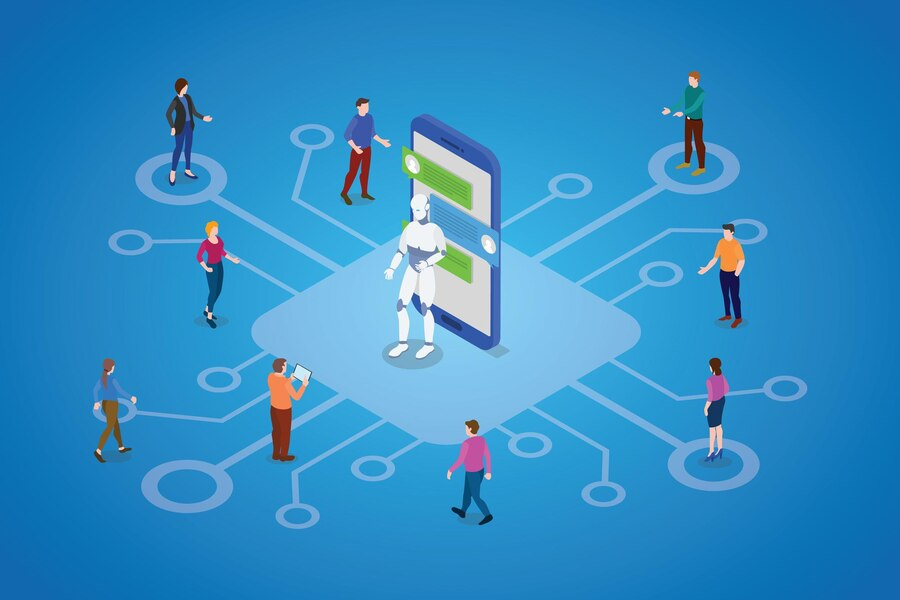Businesses are constantly searching for ways to connect with their customers on a deeper level. One strategy that has gained significant traction in recent years is omnichannel personalization.
This approach allows companies to deliver tailored experiences across multiple channels, providing customers with the seamless, personalized interactions they crave. Almost 88% of customers worldwide believe that a brand’s experience is just as important as the services or products provided.
This means that you need to focus on both your deliverables as well as how you deliver them to your customers. But what exactly is omnichannel personalization and why is it so important for businesses?
In this article, we’ll delve into the world of omnichannel personalization, explore its benefits, and discuss how businesses can get started implementing this strategy.
What is Omnichannel Personalization?

Personalized omnichannel marketing is the practice of tailoring marketing messages and customer experiences across multiple channels to create a cohesive and personalized journey for each individual. Unlike traditional marketing approaches that focus on delivering a one-size-fits-all message, personalization takes into account a customer’s preferences, behaviors, and interactions across various touchpoints.
Imagine a scenario where a customer interacts with a company through different channels such as social media, email, and in-store visits. With omnichannel personalization, the company can gather data from each touchpoint and use it to create a unified view of the customer. This comprehensive understanding enables businesses to deliver personalized content and experiences that resonate with customers on an individual level.
The Need for Omnichannel Personalization
In today’s hyper-connected world, customers expect personalized experiences at every stage of their journey. According to research conducted by Accenture Interactive, 91% of consumers are more likely to shop with brands that provide relevant offers and recommendations. Furthermore, 83% of consumers are willing to share their data in exchange for more personalized experiences.
The rise of e-commerce has also intensified the need for seamless omnichannel marketing. With online shopping becoming increasingly popular, businesses need to find creative ways to stand out from the competition and engage customers effectively. By implementing a personalized digital experience, companies can create unique, tailored experiences that cultivate customer loyalty and drive business growth.
7 Benefits of Omnichannel Personalization
Here are some of the key benefits you can gain with omnichannel personalization in your arsenal:
1. Enhanced Customer Experience:
By delivering personalized content and experiences, businesses can create a more seamless and enjoyable customer journey. When customers feel understood and valued, they are more likely to engage with a brand and make repeat purchases.
2. Increased Customer Loyalty:
Omnichannel personalization platforms allow businesses to foster long-term relationships with their customers. By consistently delivering relevant and personalized interactions, companies can build trust and loyalty, leading to increased customer retention and advocacy.
3. Improved Conversion Rates:
Personalized marketing messages have been shown to significantly improve conversion rates. According to research, 80% of consumers are more likely to make a purchase when brands offer personalized experiences.
4. Higher Revenue Generation:
Companies that implement omnichannel personalization strategies outperform their competitors in revenue growth. McKinsey & Company reported that companies with strong omnichannel strategies achieve a 10% compound annual growth rate compared to 3% for those without.
5. Data-Driven Insights:
By collecting data from various touchpoints, businesses gain valuable insights into customer behaviors, preferences, and trends. These insights can inform decision-making processes and help companies optimize their marketing efforts for better results.
6. Improved Customer Retention:
A personalized experience creates a strong emotional connection with customers, making them more likely to remain loyal to a brand. By consistently delivering relevant content tailored to their needs, businesses can enhance customer retention rates.
7. Competitive Advantage:
In today’s highly competitive market, providing an exceptional customer experience sets businesses apart from their competitors. By implementing this guide to omnichannel personalization, businesses gain a competitive edge by delivering tailored experiences that resonate with their target audience.
How Does Omnichannel Personalization Work?
At its core, omnichannel personalization requires the integration of various technologies and data sources to create a unified view of the customer. Here’s a step-by-step breakdown of how the process works:
1. Data Collection:
The first step in implementing an omnichannel personalization strategy is collecting data from different touch points such as websites, mobile apps, social media platforms, and offline interactions. This data includes demographic information, browsing behavior, purchase history, preferences, and other relevant data points.
2. Data Integration:
Once the data is collected, it needs to be integrated into a centralized customer database or customer relationship management (CRM) system. This integration allows businesses to consolidate and analyze the data for a comprehensive view of each customer.
3. Customer Segmentation:
With the data in place, businesses can segment their customers based on various criteria such as demographics, behaviors, preferences, and purchase history. These segments provide a foundation for personalized marketing campaigns and experiences.
4. Personalization Strategy Development:
Once customer segments are defined, companies can develop personalized marketing strategies tailored to each segment. This may involve creating targeted email campaigns, customized website experiences, personalized product recommendations, and more.
5. Channel Integration:
Customized omnichannel marketing requires the seamless integration of various channels such as websites, mobile apps, social media platforms, email marketing, and in-store experiences. By connecting these channels and delivering consistent messaging across all touchpoints, businesses can create a cohesive and personalized experience for their customers.
6. Measurement & Optimization:
To ensure the effectiveness of their omnichannel personalization efforts, businesses need to continuously measure and optimize their strategies. This involves monitoring key performance indicators (KPIs), analyzing data insights, conducting A/B testing, and making data-driven adjustments to improve results over time.
7. Content Creation:
With customer segments defined, businesses can create tailored content that aligns with each segment’s preferences. This could include personalized product recommendations, customized email campaigns, dynamic website content, or targeted social media ads.
8. Channel Optimization:
To ensure a seamless omnichannel experience, businesses must optimize each channel for personalization. This involves creating consistent branding and messaging across all touchpoints and leveraging automation tools to deliver relevant content in real time.
9. Testing and Optimization:
Implementing an omnichannel personalization strategy requires continuous testing and optimization to ensure its effectiveness. By analyzing performance metrics and customer feedback, businesses can refine their strategies over time to drive better results.
How to Get Started with Omnichannel Personalization
Implementing an effective omnichannel personalization strategy requires careful planning and execution. Here are some steps businesses can take to get started:
1. Define Objectives:
Clearly define your objectives for implementing omnichannel personalization. Is it to enhance the customer experience? Increase sales? Improve customer retention? Having clear goals will help guide your strategy development.
2. Collect Data:
Identify the sources of data you need to collect to gain a comprehensive understanding of your customers’ preferences and behaviors. This may include website analytics tools, CRM systems, social media listening tools, and more.
3. Integrate Data:
Invest in a robust CRM system or customer data platform (CDP) that allows you to consolidate and integrate data from various sources. This will enable you to create a unified view of your customers and deliver personalized experiences.
4. Analyze Data:
Leverage data analytics tools to gain insights into customer behaviors, preferences, and trends. Use this information to segment your customers and develop targeted marketing campaigns.
5. Segment Your Audience:
Segment your audience based on relevant criteria such as demographics, behavior patterns, purchase history, or engagement levels. This segmentation will serve as the foundation for delivering personalized content.
6. Develop Personalization Strategies:
Based on your customer segments, develop personalized marketing strategies that align with their preferences and needs. This could involve creating customized email campaigns, dynamic website content, personalized product recommendations, and more.
7. Curate Personalized Content:
Create compelling, tailored content that aligns with each customer segment’s preferences and interests. Leverage automation tools to deliver this content in real-time across multiple channels.
8. Optimize Your Channels:
Ensure that each channel is optimized for personalization by creating consistent branding and messaging across touchpoints. Leverage automation and AI-powered tools to deliver personalized experiences at scale.
9. Implement Technology Solutions:
Invest in the necessary technology solutions to execute your omnichannel personalization strategies effectively. This may include marketing automation platforms, personalization engines, AI-driven analytics tools, and more.
10. Test, Measure, and Optimize:
Continuously test and measure the effectiveness of your omnichannel personalization efforts. Analyze key metrics such as conversion rates, engagement levels, and revenue generated. Use these insights to optimize your strategies for better results.
Omnichannel Personalization Best Ideas

Now that we have explored the concept of personalization in omnichannel marketing and how businesses can get started implementing this strategy, let’s dive into some best practices:
1. Tailored Email Marketing:
Customize email campaigns based on customer preferences and behaviors. Use dynamic content to deliver personalized product recommendations, exclusive offers, and relevant content based on individual interests.
2. Personalized Website Experiences:
Create dynamic website experiences by tailoring content based on previous browsing behavior or purchase history. Display recommended products or provide personalized landing pages based on specific customer segments.
3. Social Media Integration:
Leverage social media platforms to engage with customers on a more personal level. Use social listening tools to gather insights about customer sentiment and preferences and tailor your social media content accordingly.
4. Mobile App Personalization:
Customize mobile app experiences by delivering personalized notifications, recommended products, or exclusive offers based on customer behaviors and preferences. Use location-based targeting to provide relevant information based on a customer’s physical location.
5. In-Store Personalization:
Implement technologies such as beacons or RFID tags to deliver personalized experiences in-store. This could include providing targeted offers or recommendations based on a customer’s previous purchases or browsing history.
6. AI-Driven Personalization:
Leverage artificial intelligence (AI) and machine learning algorithms to automate the personalization process at scale. These technologies can analyze vast amounts of data and deliver highly personalized experiences in real time.
7. Customer Feedback and Surveys:
Regularly gather feedback from your customers through surveys or feedback forms. Use this information to continuously optimize your omnichannel personalization strategies and address any pain points or areas for improvement.
8. Dynamic Content Customization:
Tailor the content displayed on your website based on each visitor’s browsing history, demographics, or previous interactions with your brand.
9. Personalized Email Campaigns:
Create customized email campaigns that address individual customer needs, preferences, or lifecycle stages.
10. Predictive Analytics:
Utilize predictive analytics to anticipate customer needs and interests, enabling you to proactively deliver personalized recommendations or offers.
11. Social Media Listening**:
Monitor social media conversations and engage with customers in real time, responding to their queries and concerns promptly.
12. Chatbots with Personalization:
Implement chatbots that leverage personalized data to provide relevant and tailored responses to customer inquiries.
13. Cross-Channel Consistency:
Ensure a consistent brand experience across all channels by aligning messaging, visuals, and branding elements.
Conclusion
Omnichannel personalization is no longer a luxury for businesses; it has become a necessity in today’s competitive landscape. With the right technology solutions and a data-driven approach, businesses can deliver personalized experiences that resonate with their customers across multiple channels.
As the digital world continues to evolve, omnichannel personalization will play an increasingly vital role in helping businesses stay ahead of the curve. Experts like Konnect Insights can accelerate this growth to help companies forge stronger connections with their customers.






























